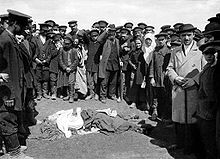Catastrophe at the coronation ceremonies of Emperor Nicholas II.

The disaster at the coronation celebrations of Emperor Nicholas II was a mass panic that occurred on May 18, 1896 on the Chodynka field near Moscow . 1,389 people died and 1,300 were injured. The disaster is one of the mass panics with the highest number of deaths.
procedure
After the coronation of Nicholas II on May 14, 1896, a large folk festival was to take place in his honor four days later opposite the Petrovsk Palace on the field of Chodynka, which was used by the Moscow garrison as a military training area. The field was criss-crossed by ditches, which later contributed to the dramatic outcome of the event. At ten o'clock in the morning 400,000 gifts were to be distributed to the crowd, consisting of a bundle of food and various items, including an enamelled mug with the tsar's coat of arms . 150 buffets were to feed the people, and music groups and theater troupes provided entertainment in ten pavilions. At 2 p.m. the Tsar was supposed to show himself in person.
Many Muscovites came to the field during the night so as not to miss the distribution of the gifts in the morning. In the moonless night the area was completely dark and many newcomers were already falling into the trenches. Half a million people crowded the area in the morning. The insufficient number of law enforcement officers quickly realized that the situation was becoming threatening and that they would not be able to cope with such a crowd. The accident happened at six in the morning. Due to a rumor that gifts were already being distributed, the crowd rushed to the established buffets.
The eyewitness and journalist Vladimir Gilyarovsky later wrote: “The crowd was terrible. Many got sick and some lost consciousness without having had the opportunity to come out or even to fall over: unconscious, with their eyes closed, wedged in as in a vise, they swayed to and fro with the crowd ... One near me next to mine The tall, well-formed old man standing next to him had not breathed for a long time: he had suffocated in silence, died without a sound, and his cold corpse swayed with us to and fro. "
The disaster began by pushing people into a 90 meter long and approximately three meter deep trench that ran through the field. Those who came up did not notice this and so more and more fell into the ditch and buried those below them. A total of 1,389 people died.
consequences
On the day of the accident, Nikolaus wrote in his diary: "Thank God everything has been running like clockwork, but today a great accident happened." Together with his wife Alexandra he visited the injured in hospitals that day. The family of every person killed should receive 1000 rubles from their personal wealth. Every victim should have a funeral at their own expense. However, public opinion was strongly influenced by the fact that the tsar attended a ball at the French legation that evening. The French were Russia's only real allies in Europe, and so Nicholas was persuaded by his uncle Sergei Alexandrovich to attend the ball so as not to jeopardize these relations. Public opinion of Nicholas remained throughout his tenure as someone who did not care about the misfortunes of his people.
Nikolaus ordered an investigation into the incidents, which revealed that Nikolaus' uncle, who had been preparing the celebrations since February, should be held responsible for the accident. Nikolaus shrank from serious consequences. The royal family convinced him that the monarchy would lose its authority if members were publicly accused. Instead, Moscow's Chief Police Officer Alexander Alexandrovich Vlasovsky was brought to justice. Despite this, the Russian people continued to believe that Sergei Alexandrovich was actually responsible; henceforth the vernacular referred to him as "Prince Chodynskij".
The Russian poet Konstantin Balmont wrote in a poem in 1908 about Tsar Nicholas: "Anyone who began his rule with Chodynka will end on the scaffold ." In fact, he was ousted in 1917 during the February Revolution and murdered with his family a year later .
literature
- Helen S. Baker: Nicholas II and the Khodynka coronation catastrophe, May 1896: a study of contemporary responses. (Dr. David N. Collins.) Leeds Ph.D. 2002.
- Pyotr Krasnow : From the Tsar's Eagle to the Red Flag (historical novel in three volumes, Berlin 1923), Volume 1, Chapters 39 to 41.
Web links
swell
- ↑ The Ten Deadliest Mass Panics
- ↑ a b c Article on the coronation of the emperor
- ↑ a b P. J. Blumenthal : Scenes that made history. PM-Magazin , Riva-Verlag 2003, ISBN 3-936994-02-1 , p. 129, limited preview in the Google book search.
- ↑ Article on koshka-the-cat.com
- ↑ a b Kathleen Klotchkov: The long way to the festival: the history of the Moscow city foundation celebrations from 1847 to 1947 . In: History . tape 5 . Frank & Timme GmbH, Berlin 2006, ISBN 3-86596-051-0 , p. 132 (372 p., Limited preview in the Google book search - diploma thesis / dissertation).
- ↑ The poem Nasch Tsar by Konstantin Balmot on lib.ru (Russian)
